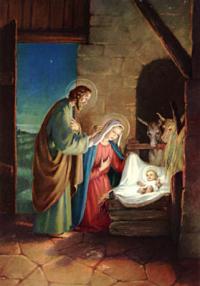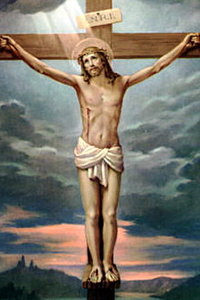Rosary
|
|
The Rosary (its name comes from the Latin "rosarium," meaning "crown of roses"), is an important and traditional devotion of the Roman Catholic Church, combining prayer and meditation in sequences of ten "Hail Marys," each sequence being called a decade. A complete Rosary involves the completion of fifteen (now twenty) decades.
| Contents |
The Mysteries
A recitation of the Rosary was traditionally dedicated to one of three sets of "mysteries" to be said in sequence, one per night; the Joyful Mysteries, Sorrowful Mysteries, and the Glorious Mysteries. In an unprecedented break with tradition, Pope John Paul II in his encyclical Rosarium Virginis Mariae (October 2002) introduced a fourth, optional set, called the Luminous Mysteries. Each set has within it five different themes to be meditated on, one for each decade of ten Hail Marys.
(The list of mysteries below corresponds to moments in the life and death of Jesus and Mary chronologically.)
Joyful
(To be recited on Mondays and Saturdays)
- The Annunciation
- The Visitation
- The Nativity
- The Presentation at the Temple
- The Finding in the Temple
Luminous
(To be recited on Thursdays)
- The Baptism of Jesus
- The Wedding of Cana
- The Proclamation of the Kingdom of God
- The Transfiguration
- The Institution of the Eucharist
Sorrowful
(To be recited on Tuesdays and Fridays)
- The Agony in the Garden
- The Scourging at the Pillar
- The Crowning with Thorns
- The Carrying of the Cross
- The Crucifixion and Death of Jesus
Glorious
(To be recited on Wednesdays and Sundays)
- The Resurrection of Jesus
- The Ascension of Jesus
- The Descent of the Holy Spirit
- The Assumption of the Virgin Mary
- The Coronation of the Blessed Virgin Mary
The origins of the Rosary
The historical record indicates that similar bead-prayers date to the earliest times of the Church (indeed, similar prayer beads are found in many religions, and some have been found dating back to antiquity). A common practice was to pray on "Pater Noster beads", where one would pray the "Our Father" according to the number of beads on the necklace. According to Tradition, in 1214 the Virgin Mary gave to St. Dominic the basic form of the Rosary as it is known today, with minor variations in the wording of the Hail Mary, such as the addition of the Name "Jesus" by St. Bernardine of Siena (1380-1444).
In her apparition at Fatima (1917), the Virgin Mary revealed that every time a Hail Mary is recited, it is as if a rose was offered Her, so a complete Rosary is like a crown of roses. (This idea of a Rosary being a crown predates Fatima by centuries, and was expressed on several occasions by mediaeval and later Catholics, notably St. Louis de Montfort in his promotional book Secrets of the Rosary.)
Rosary beads
Rosary.jpeg
Rosary Beads usually contain 50 beads in groups of ten (the decades), with an additional large bead before each decade. Some beads have been known to have one hundred or one hundred and fifty are also known. These numbers were chosen to match the number of psalms, or a third or two-thirds of them. This was because in ancient times monks and clergy used to recite the entire psalter every day; the practice of saying one hundred and fifty Pater Nosters (Our Fathers in Latin) developed as an alternative for those who were illiterate or who could not afford a psalter. It was only in the Middle Ages, however, when prayer to Mary became common among Catholics, that the use of Ave Marias instead of Pater Nosters came about. The beads were traditionally made from the seeds of the "bead tree", but are now more usually made of artificial materials. A set of Rosary Beads is considered a sacramental.
Traditionally, 15 decades used to be said in total, a total increased to 20 with the addition of the "Luminous Mysteries" in 2002 by Pope John Paul II. Some Catholics, particularly those who regard themselves as Traditional Catholics, continue to observe the more traditional form of the Rosary and do not include the "Luminous Mysteries" in their recitation of the Rosary.
Each decade of the Rosary traditionally corresponds to a mystery of Redemption, although the mysteries did not originate until the 15th or 16th century, and even then there was not universal agreement on what they were.
In a common form, the beads are true olive seeds; in past times there was a respectable trade in Rosaries made with olive seeds supposedly from the Garden of Gethsemane. Beads are sometimes made with sacred relics.
Types of Rosaries
Some national variations in terms of prayers used and structure occur in the form of the recitation of the Rosary.
One frequently used form
- a sign of the cross on the Crucifix and then the "Apostles Creed";
- an "Our Father" on the first large bead;
- a "Hail Mary" on each of the three small beads;
- a "Glory Be to the Father" on the next large bead;
- a "Fatima Prayer" on the large bead;
- an "Our Father" on the large bead;
- a "Hail Mary" on each of the adjacent ten small beads;
- a "Glory Be to the Father" on the next large bead;
- again an Our Father, ten Hail Marys, the Glory Be to the Father, and Fatima Prayer for each of the following decades;
- a "Hail Mary" and a sign of the cross.
A regularly used alternative
- Opening prayer (variable)
- One "Our Father", three "Hail Marys", one "Glory Be to the Father"
- Decade 1: One "Our Father", Ten "Hail Marys", One "Glory Be to the Father"
- Fatima Prayer
- Decade 2
- Fatima Prayer
- Decade 3
- Fatima Prayer
- Decade 4
- Fatima Prayer
- Decade 5
- Prayer: Hail, holy Queen, Mother of Mercy! Our life, our sweetness, and our hope! To thee do we cry, poor banished children of Eve; to thee do we send up our sighs, mourning and weeping in this valley of tears. Turn, then, most gracious Advocate, thine eyes of mercy toward us; and after this our exile show unto us the blessed fruit of thy womb, Jesus; O clement, O loving, O sweet Virgin Mary. Pray for us, that we may be made worthy of the Promises of Christ.
- Litany (the response after each is "Pray for Us")
- Holy Mary, Holy Mother of God, Holy Virgin of virgins, Mother of Christ, Mother of divine grace, Mother most pure, Mother most chaste, Mother inviolate, Mother undefiled, Mother most amiable, Mother most admirable, Mother of good counsel, Mother of our Creator, Mother of our Savior, Virgin most prudent, Virgin most venerable, Virgin most renowned, Virgin most powerful, Virgin most merciful, Virgin most faithful, Mirror of justice, Seat of wisdom, Cause of our joy, Spiritual vessel, Vessel of honor, Singular vessel of devotion, Mystical rose, Tower of David, Tower of ivory, House of gold, Ark of the covenant, Gate of heaven, Morning star, Health of the Sick, Refuge of sinners, Comforter of the afflicted, Help of Christians, Queen of Angels, Queen of Patriarchs, Queen of Prophets, Queen of Apostles, Queen of Martyrs, Queen of Confessors, Queen of Virgins, Queen of all Saints, Queen conceived without original sin, Queen assumed into heaven, Queen of the most holy Rosary, Queen of Peace. Pray for Us.
- Lamb of God, who take away the sins of the world,
- R/ Have Mercy on Us
- Lamb of God, who take away the sins of the world,
- R/ Have Mercy on Us
- Lamb of God, who take away the sins of the world.
- R/ Hear Our Prayer
- Pray for us, O holy Mother of God.
- R/ That we may be made worthy of the promises of Christ.
- Final prayer (variable)
- One Our Father, three Hail Marys, One Glory be to the Father.
Non-Roman Catholics and the Rosary
Eastern Christians also use similar strings of beads to pray, although among the Orthodox their use is mainly restricted to monks and bishops, not being common among laity or secular clergy. Many Eastern Christians use a prayer rope instead; its use is much more prevalent, and it is typically associated with the Jesus Prayer.
Some Anglicans pray the Rosary, but another form of prayer beads is popular among Anglicans/ Episcopalians. Originally called Anglican prayer beads, this bead set is also known as "Christian prayer beads" because of the popularity it has found among Protestants generally. The term "Anglican Rosary" is sometimes also used.
Anglican bead sets contain 28 beads in groups of seven (the "weeks"), with an additional large bead before each. In total, there are thirty-three beads representing the years of Jesus' life on Earth. The most common prayer used is the Jesus Prayer, but there are no appointed prayers or meditations.
Other faiths also use similar objects for prayer, including Sufi Muslims, certain Buddhist groups, and some Hindus (see japa mala), among others.
Rosaries Worn Outside of Religion
YoungWomanWearingRosary.jpg
Rosaries are often worn for non-religious purposes as a fashion or jewelery item, though this is against Catholic custom, and are sold in different variations in popular jewelry and clothing stores. They were heavily popularised by singer Madonna in the early 1980s.
See also
- prayer
- Blessed Virgin Mary
- Legion of Mary
- Rosary Army.
- Compare: prayer rope, japa mala (Indian rosary)
External links
- Rosaryparts.com (http://www.rosaryparts.com) - If you want to make rosaries, these people have all the parts you will need.
- Virtual Rosary (http://virtualrosary.org) Online interactive Rosary and global prayer network.
- The Rosary: Mary's Psalter (http://www.kensmen.com/catholic/rosary.html) with prayers in English and Latin, and readings for the Mysteries
- Praying the Rosary (http://www.religionfacts.com/christianity/practices/praying_rosary.htm) History, meaning, prayers, and mysteries of the rosary
- RosaryArmy.com (http://www.RosaryArmy.com/) Learn how to make a rosary
- http://www.theholyrosary.org/
- http://www.newadvent.org/cathen/13184b.htm
- Secret of the Rosary (http://www.theworkofgod.org/Devotns/Rosary/Rsecrets/secret.htm) St. Louis de Montfort's entertaining 16th century text online, with many anecdotes about the benefits of the Rosary.
- The Online Rosary (http://www.easterbrooks.com/personal/calendar/rosary.html)
- Rosary Center (http://www.rosary-center.org/) The Rosary Center -- A website maintained by the Dominican Fathers and Headquarters of the Rosary Confraternity
- Ecumenical Rosary (http://www.ecumenicalrosary.org/)de:Rosenkranz
es:Rosario (Catolicismo) fr:Rosaire it:Rosario nl:Rozenkrans ja:ロザリオ pl:Różaniec





